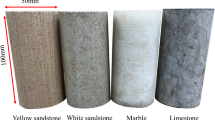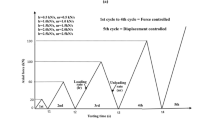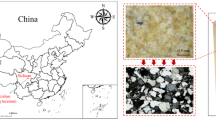Abstract
Freeze–thaw weathering pointedly deteriorates rocks’ strength and plays a significant role in rockmass instability in cold regions. Therefore, acoustic emission (AE) signals and energy evolution during uniaxial compressive loading were used to predict failure and estimate the microcracks evolution of sandstone, marble, and granite under freeze–thaw weathering. Moreover, the AE energy mutation rate (AEEMR) was evaluated from AE signals to identify the pre-failure peaks of rock deformation. The AE signals, i.e., AE energy, have successively traced the distinct stage characteristics during the loading process. The AEEMR curves consecutively enhanced the pre-failure peaks of AE energy curves. Further, the ratios of dissipation to the total energy (RDT), elastic to dissipation energy (RED), and energy dissipation rate (EDR) were adopted to predict the violent failure of different rocks. The results demonstrated that the precursory information of RDT and RED was more manifest than that of EDR curves. The RDT and RED gave precursory points earlier than EDR. It was also observed that the freeze–thaw weathering affected the failure and precursory time of rocks. Furthermore, the microcracks evolution was assessed using the (average frequency) AF and (the gradient of the waveform rise) RA values distribution line and 2D Kernel density estimation (KDE) map. The freeze–thaw weathering barely influenced the cracks’ transformation from tensile to shear, but the tensile cracks were further espoused notably. The outcomes of this research work will be beneficial in understanding the failure mechanism and prediction of different rocks under extreme frigid environments.















Similar content being viewed by others
Data availability
Data will be made available on request.
References
Aggelis DG (2011) Classification of cracking mode in concrete by acoustic emission parameters. Mech Res Commun 38:153–157. https://doi.org/10.1016/j.mechrescom.2011.03.007
Aldahdooh MAA, Muhamad Bunnori N (2013) Crack classification in reinforced concrete beams with varying thicknesses by mean of acoustic emission signal features. Constr Build Mater 45:282–288. https://doi.org/10.1016/J.CONBUILDMAT.2013.03.090
Ali M, Khan NM, Gao Q, Cao K, Armaghani DJ, Alarifi SS, Rehman H, Jiskani IM (2023) Prediction of coal dilatancy point using acoustic emission characteristics : insight experimental and artificial intelligence approaches. Mathematics 11(6):1305. https://doi.org/10.3390/math11061305
Basu A, Mishra DA, Roychowdhury K (2013) Rock failure modes under uniaxial compression, Brazilian, and point load tests. Bull Eng Geol Environ 72:457–475. https://doi.org/10.1007/s10064-013-0505-4
Cai X, Zhou Z, Liu K, Du X, Zang H (2019) Water-weakening effects on the mechanical behavior of different rock types: phenomena and mechanisms. Appl Sci 9:14–28. https://doi.org/10.3390/app9204450
Cai X, Zhou Z, Zang H, Song Z (2020) Water saturation effects on dynamic behavior and microstructure damage of sandstone: phenomena and mechanisms. Eng Geol 276:105760. https://doi.org/10.1016/j.enggeo.2020.105760
Cai X, Cheng C, Zhou Z, Konietzky H, Song Z, Wang S (2021) Rock mass watering for rock-burst prevention: some thoughts on the mechanisms deduced from laboratory results. Bull Eng Geol Environ 80:8725–8743. https://doi.org/10.1007/s10064-021-02467-0
Cai X, Yuan J, Zhou Z, Pi Z, Tan L, Wang P, Wang S, Wang S (2023) Effects of hole shape on mechanical behavior and fracturing mechanism of rock: implications for instability of underground openings. Tunn Undergr Sp Technol 141:105361. https://doi.org/10.1016/j.tust.2023.105361
Cao K, Ma L, Wu Y, Khan NM, Yang J (2020a) Using the characteristics of infrared radiation during the process of strain energy evolution in saturated rock as a precursor for violent failure. Infrared Phys Technol 109. https://doi.org/10.1016/j.infrared.2020.103406
Cao K, Ma L, Wu Y, Spearing AJS, Khan NM, Xie Y (2020b) The determination of a damage model for mudstone under uniaxial loading in acidic conditions. Geofluids 2020. https://doi.org/10.1155/2020/8888750
Chen TC, Yeung MR, Mori N (2004) Effect of water saturation on deterioration of welded tuff due to freeze-thaw action. Cold Reg Sci Technol. https://doi.org/10.1016/j.coldregions.2003.10.001
Chen L, Li K, Song G, Zhang D, Liu C (2021) Effect of freeze–thaw cycle on physical and mechanical properties and damage characteristics of sandstone. Sci Rep 11:1–10. https://doi.org/10.1038/s41598-021-91842-8
Deng H, Yu S, Deng J, Ke B, Bin F (2019) Experimental investigation on energy mechanism of freezing-thawing treated sandstone under uniaxial static compression. KSCE J Civ Eng 23:2074–2082. https://doi.org/10.1007/s12205-019-1278-5
Deprez M, De Kock T, De Schutter G, Cnudde V (2020) A review on freeze-thaw action and weathering of rocks. Earth-Sci Rev 203. https://doi.org/10.1016/j.earscirev.2020.103143
Dong L, Zhang Y, Ma J (2020) Micro-crack mechanism in the fracture evolution of saturated granite and enlightenment to the precursors of instability. Sensors (Basel) 20. https://doi.org/10.3390/s20164595
Du K, Li X, Tao M, Wang S (2020) Experimental study on acoustic emission (AE) characteristics and crack classification during rock fracture in several basic lab tests. Int J Rock Mech Min Sci 133. https://doi.org/10.1016/j.ijrmms.2020.104411
Feng J, Wang E, Chen X, Ding H (2018) Energy dissipation rate: an indicator of coal deformation and failure under static and dynamic compressive loads. Int J Min Sci Technol 28:397–406. https://doi.org/10.1016/j.ijmst.2017.11.006
Gao F, Cao S, Zhou K, Lin Y, Zhu L (2020) Damage characteristics and energy-dissipation mechanism of frozen–thawed sandstone subjected to loading. Cold Reg Sci Technol 169:102920. https://doi.org/10.1016/j.coldregions.2019.102920
Gao A, Qi C, Shan R, Wang C (2022) Experimental study on the spatial-temporal failure characteristics of red sandstone with a cemented structural surface under compression. ACS Omega 7:20250–20258. https://doi.org/10.1021/acsomega.2c02169
He MM, Pang F, Wang HT, Zhu JW, Chen YS (2020) Energy dissipation-based method for strength determination of rock under uniaxial compression. Shock Vib 2020. https://doi.org/10.1155/2020/8865958
Kawasaki Y, Tomoda Y, Ohtsu M (2010) AE monitoring of corrosion process in cyclic wet–dry test. Constr Build Mater 24:2353–2357. https://doi.org/10.1016/J.CONBUILDMAT.2010.05.006
Khan NM, Ma L, Cao K, Hussain S, Liu W, Xu Y, Yuan Q, Gu J (2021) Prediction of an early failure point using infrared radiation characteristics and energy evolution for sandstone with different water contents. Bull Eng Geol Environ 80:6913–6936. https://doi.org/10.1007/s10064-021-02345-9
Khazaei C, Hazzard J, Chalaturnyk R (2015) Damage quantification of intact rocks using acoustic emission energies recorded during uniaxial compression test and discrete element modeling. Comput Geotech 67:94–102. https://doi.org/10.1016/j.compgeo.2015.02.012
Kong B, Wang E, Li Z, Wang X, Chen L, Kong X (2016) Nonlinear characteristics of acoustic emissions during the deformation and fracture of sandstone subjected to thermal treatment. Int J Rock Mech Min Sci 90:43–52. https://doi.org/10.1016/j.ijrmms.2016.10.004
Lei D, Lin H, Chen Y, Cao R, Wen Z (2019a) Effect of cyclic freezing-thawing on the shear mechanical characteristics of nonpersistent joints. Adv Mater Sci Eng 2019. https://doi.org/10.1155/2019/9867681
Lei R, Wang Y, Zhang L, Liu B, Long K, Luo P, Wang YK (2019b) The evolution of sandstone microstructure and mechanical properties with thermal damage. Energy Sci Eng 7:3058–3075. https://doi.org/10.1002/ese3.480
Li X, Li H, Yang Z, Zuo H, Sun W, Li H, Li Y (2022) Coupling mechanism of dissipated energy-infrared radiation energy of the deformation and fracture of composite coal-rock under load. ACS Omega 7:8060–8076. https://doi.org/10.1021/acsomega.1c07289
Liang C, Wu S, Li X, Xin P (2015) Effects of strain rate on fracture characteristics and mesoscopic failure mechanisms of granite. Int J Rock Mech Min Sci 76:146–154. https://doi.org/10.1016/j.ijrmms.2015.03.010
Liang Y, Yang Q, Zhu L, Jiang T, Gao M (2022) Study on the acoustic emission and thermal infrared signal characteristics of granite with freeze-thaw damage in cycle loading process. Front Earth Sci 10:1–13. https://doi.org/10.3389/feart.2022.1002888
Linzer L, Mhamdi L, Schumacher T (2015) Application of a moment tensor inversion code developed for mining-induced seismicity to fracture monitoring of civil engineering materials. J Appl Geophys 112:256–267. https://doi.org/10.1016/J.JAPPGEO.2014.12.001
Liu Q, Huang S, Kang Y, Liu X (2015) A prediction model for uniaxial compressive strength of deteriorated rocks due to freeze-thaw. Cold Reg Sci Technol 120:96–107. https://doi.org/10.1016/j.coldregions.2015.09.013
Liu J, Fan X, Shi C (2021) Effect of bonding layers on dynamic fracture characteristics of FRP reinforced concrete. Constr Build Mater 309:125136. https://doi.org/10.1016/j.conbuildmat.2021.125136
Liu X, Xue Y, Zheng Y, Li H (2022) Research on failure precursor based on characteristics of energy dissipation rate for rock. Front Earth Sci 9:1–12. https://doi.org/10.3389/feart.2021.812438
Ma Q, Ma D, Yao Z (2018) Influence of freeze-thaw cycles on dynamic compressive strength and energy distribution of soft rock specimen. Cold Reg Sci Technol 153:10–17. https://doi.org/10.1016/j.coldregions.2018.04.014
Ma L, Khan NM, Cao K, Rehman H, Salman S, Rehman FU (2022) Prediction of sandstone dilatancy point in different water contents using infrared radiation characteristic: experimental and machine learning approaches. Lithosphere 2022. https://doi.org/10.2113/2022/3243070
Moradian Z, Einstein HH, Ballivy G (2016) Detection of cracking levels in brittle rocks by parametric analysis of the acoustic emission signals. Rock Mech Rock Eng 49:785–800. https://doi.org/10.1007/s00603-015-0775-1
Ohno K, Ohtsu M (2010) Crack classification in concrete based on acoustic emission. Constr Build Mater 24:2339–2346. https://doi.org/10.1016/J.CONBUILDMAT.2010.05.004
Qiao C, Song Z, Wang Y, Tannant D, Li C (2022) Fractures and acoustic emission features of non-persistent jointed rocks subjected to freeze–thaw-compression load: experimental insights. Rock Mech Rock Eng 55:109–123. https://doi.org/10.1007/s00603-021-02667-w
Sardana S, Sinha RK, Verma AK, Jaswal M, Singh TN (2022a) Influence of freeze–thaw on the stability of road cut slopes—a case study in the Indian Himalayan region. Can Geotech J 60:107–112. https://doi.org/10.1139/cgj-2021-0378
Sardana S, Sinha RK, Verma AK, Singh TN (2022b) Investigations into the freeze–thaw-induced alteration in microstructure and deteriorative responses of physico-mechanical properties of Himalayan rock. Bull Eng Geol Environ 81. https://doi.org/10.1007/s10064-022-02762-4
Shahidan S, Pulin R, Muhamad Bunnori N, Holford KM (2013) Damage classification in reinforced concrete beam by acoustic emission signal analysis. Constr Build Mater 45:78–86. https://doi.org/10.1016/J.CONBUILDMAT.2013.03.095
Srinivasan V, Hasainar H, Singh TN (2022) Experimental study on failure and fracturing attributes of granite after thermal treatments with different cooling conditions. Eng Geol 310:106867. https://doi.org/10.1016/j.enggeo.2022.106867
Su Z, Geng K, Zhou F, Sun J, Yu H (2021) Influence of freeze-thaw cycles on acoustic emission characteristics of granite samples under triaxial compression. Adv Civ Eng 2021. https://doi.org/10.1155/2021/5571680
Sun B, Hou S, Xie J, Zeng S (2019) Failure prediction of two types of rocks based on acoustic emission characteristics. Adv Civ Eng 2019. https://doi.org/10.1155/2019/5028489
The Professional Standards Compilation Group of People Republic of China (2001) SL264–2001 specifications for rock test in water conservancy and hydroelectric engineering. China Water Power Press, Beijing (in Chinese)
Verma AK, Sardana S, Jaiswal A (2023) Study of freeze-thaw induced damage characteristic for Himalayan schist. J Geol Soc India 99:390–396. https://doi.org/10.1007/s12594-023-2322-0
Wang H, Liu D, Cui Z, Cheng C, Jian Z (2016) Investigation of the fracture modes of red sandstone using XFEM and acoustic emissions. Theor Appl Fract Mech 85:283–293. https://doi.org/10.1016/J.TAFMEC.2016.03.012
Wang M, Tan C, Meng J, Yang B, Li Y (2017a) Crack classification and evolution in anisotropic shale during cyclic loading tests by acoustic emission. J Geophys Eng 14:930–938. https://doi.org/10.1088/1742-2140/aa6f24
Wang P, Xu J, Fang X, Wang P (2017b) Energy dissipation and damage evolution analyses for the dynamic compression failure process of red-sandstone after freeze-thaw cycles. Eng Geol 221:104–113. https://doi.org/10.1016/j.enggeo.2017.02.025
Wang Y, Feng WK, Wang HJ, Li CH, Hou ZQ (2020a) Rock bridge fracturing characteristics in granite induced by freeze-thaw and uniaxial deformation revealed by AE monitoring and post-test CT scanning. Cold Reg Sci Technol 177. https://doi.org/10.1016/j.coldregions.2020.103115
Wang Y, Han JQ, Li CH (2020b) Acoustic emission and CT investigation on fracture evolution of granite containing two flaws subjected to freeze–thaw and cyclic uniaxial increasing-amplitude loading conditions. Constr Build Mater 260. https://doi.org/10.1016/j.conbuildmat.2020.119769
Wang Y, Gao SH, Li CH, Han JQ (2021a) Energy dissipation and damage evolution for dynamic fracture of marble subjected to freeze-thaw and multiple level compressive fatigue loading. Int J Fatigue 142. https://doi.org/10.1016/j.ijfatigue.2020.105927
Wang Y, Zhang B, Gao SH, Li CH (2021b) Investigation on the effect of freeze-thaw on fracture mode classification in marble subjected to multi-level cyclic loads. Theor Appl Fract Mech 111. https://doi.org/10.1016/j.tafmec.2020.102847
Wang Y, Han J, Xia Y, Long D (2022) New insights into the fracture evolution and instability warning predication for fissure-contained hollow-cylinder granite with different hole diameter under multi-stage cyclic loads. Theor Appl Fract Mech 119:103363. https://doi.org/10.1016/j.tafmec.2022.103363
Wang X, Zhao Y, Gao Y, Sun Z, Liu B, Jiang Y (2023) Energy evolution of anthracite considering anisotropy under high confining pressure: an experimental investigation. Rock Mech Rock Eng 56:6735–6759. https://doi.org/10.1007/s00603-023-03398-w
Weng L, Wu Z, Liu Q (2020a) Dynamic mechanical properties of dry and water-saturated siltstones under sub-zero temperatures. Rock Mech Rock Eng. https://doi.org/10.1007/s00603-019-02039-5
Weng L, Wu Z, Taheri A, Liu Q, Lu H (2020b) Deterioration of dynamic mechanical properties of granite due to freeze-thaw weathering: Considering the effects of moisture conditions. Cold Reg Sci Technol 176. https://doi.org/10.1016/j.coldregions.2020.103092
Weng L, Wu Z, Liu Q, Chu Z, Zhang S (2021) Evolutions of the unfrozen water content of saturated sandstones during freezing process and the freeze-induced damage characteristics. Int J Rock Mech Min Sci 142:104757. https://doi.org/10.1016/j.ijrmms.2021.104757
Xu D, Wu Y, Cao K, Muhammad Khan N, Hussain S, Lee S, Ma C (2021) Analysis of mudstone fracture and precursory characteristics after corrosion of acidic solution based on dissipative strain energy. Sustain 13:1–17. https://doi.org/10.3390/su13084478
Yao Q, Chen T, Tang C, Sedighi M, Wang S, Huang Q (2019) Influence of moisture on crack propagation in coal and its failure modes. Eng Geol 258:105156. https://doi.org/10.1016/J.ENGGEO.2019.105156
Zhang QB, Zhao J (2014) Quasi-static and dynamic fracture behaviour of rock materials: phenomena and mechanisms. Int J Fract 189:1–32. https://doi.org/10.1007/s10704-014-9959-z
Zhang M, Meng Q, Liu S (2017) Energy evolution characteristics and distribution laws of rock materials under triaxial cyclic loading and unloading compression. Adv Mater Sci Eng 2017. https://doi.org/10.1155/2017/5471571
Zhang H, Wang Z, Song Z, Zhang Y, Wang T, Zhao W (2021a) Acoustic emission characteristics of different brittle rocks and its application in brittleness evaluation. Geomech Geophys Geo-Energy Geo-Resour 7:1–14. https://doi.org/10.1007/s40948-021-00246-5
Zhang X, Cui X, Tang Q, Sun Y (2021b) Acoustic emission investigation on crack propagation mode of sandstone during brazil splitting process. Geotech Geol Eng 39:2863–2870. https://doi.org/10.1007/s10706-020-01660-4
Zhang J, Zhang X, Chen W, Huang Z, Du R (2022) A constitutive model of freeze–thaw damage to transversely isotropic rock masses and its preliminary application. Comput Geotech 152:105056. https://doi.org/10.1016/j.compgeo.2022.105056
Zhao TB, Zhang PF, Guo WY, Xiao YX, Zhao YQ, Sun X (2021) Research on mechanical properties and acoustic emission characteristics of rock beams with different lithologies and thicknesses. Lat Am J Solids Struct 18:1–16. https://doi.org/10.1590/1679-78256711
Zhou KP, Li B, Li JL, Deng HW, Bin F (2015) Microscopic damage and dynamic mechanical properties of rock under freeze–thaw environment. Trans Nonferrous Met Soc China 25:1254–1261. https://doi.org/10.1016/S1003-6326(15)63723-2
Zhou XP, Lian YJ, Wong LNY, Berto F (2018) Understanding the fracture behavior of brittle and ductile multi-flawed rocks by uniaxial loading by digital image correlation. Eng Fract Mech 199:438–460. https://doi.org/10.1016/J.ENGFRACMECH.2018.06.007
Zhou Z, Cai X, Li X, Cao W, Du X (2020) Dynamic response and energy evolution of sandstone under coupled static–dynamic compression: insights from experimental study into deep rock engineering applications. Rock Mech Rock Eng 53:1305–1331. https://doi.org/10.1007/s00603-019-01980-9
Zhou Z, E Y, Cai X, Zhang J (2021) Coupled effects of water and low temperature on quasistatic and dynamic mechanical behavior of sandstone. Geofluids 2021:1–12. https://doi.org/10.1155/2021/9926063
Zhou C, Yang Y, Hou S, Cai C, Li F, Xu C (2022a) Experimental investigation on mechanical properties of coal samples under different freeze–thaw cycles. Energy Explor Exploit 40:1649–1667. https://doi.org/10.1177/01445987221106567
Zhou Z, Lu J, Cai X, Rui Y, Tan L (2022b) Water saturation effects on mechanical performances and failure characteristics of rock-concrete disc with different interface dip angles. Constr Build Mater 324:126684. https://doi.org/10.1016/j.conbuildmat.2022.126684
Zhou Z, Ullah B, Rui Y, Cai X, Lu J (2023a) Predicting the failure of different rocks subjected to freeze-thaw weathering using critical slowing down theory on acoustic emission characteristics. Eng Geol 316:107059. https://doi.org/10.1016/j.enggeo.2023.107059
Zhou Z, Wang P, Cai X, Cao W (2023b) Influence of water content on energy partition and release in rock failure : implications for water-weakening on rock-burst proneness. Rock Mech Rock Eng 56:6189–6205. https://doi.org/10.1007/s00603-023-03379-z
Funding
This work is supported by the National Key Research and Development Program of China (2022YFC2903901), the National Natural Science Foundation of China (52334003, 52274249, 52104111), the Xiaohe Sci-Tech Talents Special Funding under Hunan Provincial Sci-Tech Talents Sponsorship Program (2023TJ-X80) and the Fundamental Research Funds for the Central Universities of Central South University (2023ZZTS0713). The authors are very grateful to the financial contribution and convey their appreciation for supporting this basic research.
Author information
Authors and Affiliations
Corresponding author
Rights and permissions
Springer Nature or its licensor (e.g. a society or other partner) holds exclusive rights to this article under a publishing agreement with the author(s) or other rightsholder(s); author self-archiving of the accepted manuscript version of this article is solely governed by the terms of such publishing agreement and applicable law.
About this article
Cite this article
Ullah, B., Zhou, Z., Cai, X. et al. Failure prediction and microcracks development based on acoustic emission and energy evolution for different rocks treated with freeze–thaw weathering. Bull Eng Geol Environ 82, 471 (2023). https://doi.org/10.1007/s10064-023-03485-w
Received:
Accepted:
Published:
DOI: https://doi.org/10.1007/s10064-023-03485-w




